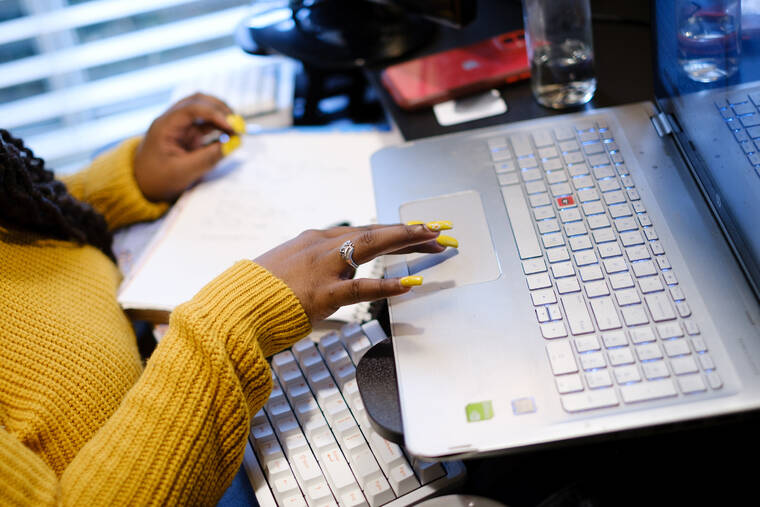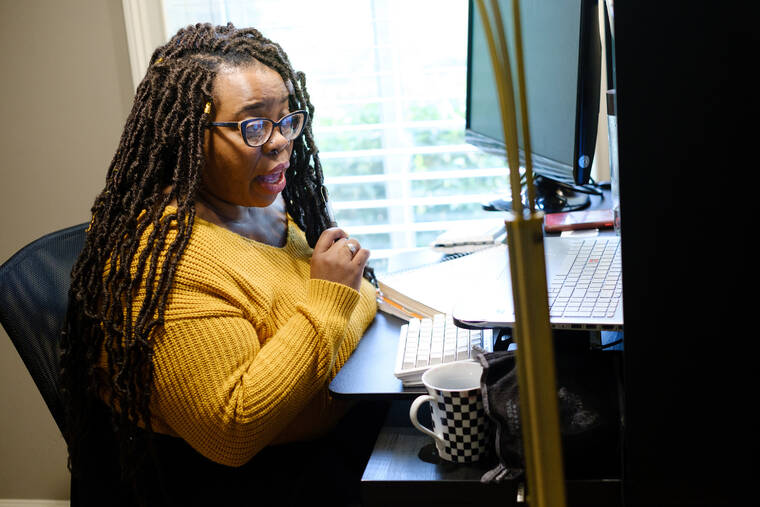Pandemic economy: Americans richer, but wealth gap a roller coaster

Financial consultant Mishana Carson, owner of Phoenix Wealth and Wellness, has a Zoom meeting from her home in Decatur, Georgia, with a client on April 18, 2022. (Arvin Temkar/Atlanta Journal-Constitution/TNS)

Financial consultant Mishana Carson, owner of Phoenix Wealth and Wellness, has a Zoom meeting from her home in Decatur, Georgia, with a client on April 18. (Arvin Temkar/Atlanta Journal-Constitution/TNS)
Most Americans have gotten wealthier during the pandemic, despite a deadly disease that upended the economy.
Most Americans have gotten wealthier during the pandemic, despite a deadly disease that upended the economy.
But economic inequality, after narrowing in 2020, appeared to widen again in 2021 as the federal government’s massive financial rescue programs began winding down.
What happens next to the size of the economic pie and how it gets sliced are open questions, even more so than in pre-pandemic times, amid greater uncertainty than normal.
Soaring inflation is eroding Americans’ purchasing power and raising the threat of a recession that would hurt everyone’s economic fortunes. A surge in self-employed workers also means a wider range of possible outcomes, good or bad, for many people embarking on the risky path of starting their own business.
But so far so good for many Americans, at least when it comes to their financial well-being, even as the country’s death toll from the coronavirus nears 1 million.
Rhomeo Mitchell of Lawrenceville, Georgia said that in early 2020 he was having trouble managing the modest paychecks he received as a video technician, living in motels. Then the pandemic hit and the shop laid him off.
But as the emergency deepened, Congress passed a major support program for the unemployed, adding $600 weekly payments for several months. The money stabilized Mitchell’s situation and he used $1,000 of it to buy a 1999 Jeep Cherokee.
Now, he works for a pest-control company checking pallets to make sure shipments have the necessary materials. He declined to say exactly how much he makes, but it more than covers the $525-a-month cost of his place in a rooming house.
“I have my freedom, I wake up every day,” said Mitchell, who is 35. “I’ve made it through the storm.”
According to JP Morgan Chase Institute, median checking account balances have risen overall during the pandemic. That has been especially true for low-income families, whose balances were 65% higher at the end of last year than in 2019.
Between February and October of 2020, the bottom half of American households saw their disposable income surge 10% — nearly twice as much as the top tenth of households, according to RealTime Inequality, a measuring tool created by Stanford economists. Even more strikingly, wealth of the bottom half grew 301% during the year — about 14 times as fast as the wealth of those in the top tenth.
That has been fueled at least in part by unprecedented federal government aid, much of it aimed at millions of low- and middle-class Americans thrown out of work in the early weeks of the pandemic. After the initial $600 weekly supplements ended, $300 weekly supplements kicked in for several months more.
Most families, except the highest earners, also were sent “stimulus” checks. Meanwhile, many renters were protected from evictions, whether they paid their landlords or not. And in 2021, many families received increased child payments instead of tax credits.
Workers in the years after World War II made strong gains and the U.S. economic inequality gap narrowed. But between 1979 and 2020, both pay and wealth at the top began to soar, and inequality steadily grew.
Then the pandemic arrived. As the economy briefly plunged and then quickly rebounded, employers struggled to fill job openings, often paying new hires more than before COVID-19.
If there’s one key sign that the economics of the pandemic have benefited lower-wage workers, it’s the unemployment rate, said economist Bruce Meyer of the University of Chicago. Before the pandemic, Georgia’s jobless rate was 3.6%. It’s now 3.1%.
“Income, spending, poverty, savings — they all roughly tell the same story,” Meyer said. “Income went up.”
When unemployment is low and wages climb, so does the leverage of workers, who can quit for a better job.
Paloma Cravey had been a human resources manager in a huge logistics company, but she moved last year to a smaller one that is tech-centric. The 31-year-old Roswell, Georgia resident is now an HR executive with better benefits and a shorter commute.
“I almost doubled my base salary,” she said. “I had a great experience and great relationships at the other job, but I thought that if I was going to make a change, this was the time to do it.”
That still doesn’t mean everyone has become financially better off during the pandemic. Industries such as logistics and tech have been booming, while many jobs in restaurants and hotels haven’t come back.
That turmoil hurt people like Paula Grisham of Decatur, Georgia, who had several part-time jobs in early 2020 before being laid off from Sunday school teaching and losing her work as a tutor for schoolchildren.
She and her husband also did home remodeling and that business did well during the pandemic, but it wasn’t enough to buy a home. She plans to buy a food truck and rebuild her income.
“Financially, I got a lot less secure,” said Grisham, who is in her 40s. “I have nowhere near what I used to make.”
The broad data often also shrouds the way that inequality hurts some groups more than others, said policy analyst Ray Khalfani at the left-leaning Georgia Budget and Policy Institute.
In Georgia, Black workers account for about 31% of the workforce. But even as the economic rebound was in full swing last fall, Black Georgians still accounted for 65% of the unemployed, he said. And while the state’s jobless rate was falling to historic lows, the unemployment rate for Black women was nearly twice the overall rate and more than twice the rate for white women.
When it comes to economic equality, there are signs it has begun swinging back to its decades-long norm of widening rather than narrowing.
Economic inequality is often measured by some combination of wealth and income. Wealthy people’s income often includes earnings from investments in things like stocks, bonds and real estate. For poorer Americans, income typically is derived wholly from wages, but was boosted in the pandemic by government aid until recently.
At the start of 2020, the bottom half of Americans had 20.1% of the nation’s after-tax income. By the spring of 2021, the bottom half had 23.9%, representing an average addition of $6,600 per earner, according to RealTime Inequality.
By last summer and fall, though, many government programs were being ratcheted back, while the stock market and home prices soared. And while the economy was frantically adding back millions of blue-collar jobs, many white-collar professionals — especially those working from home — never lost a paycheck.
By the end of last year, the bottom half’s share of after-tax income fell to 20.9%. The top tenth’s share, meanwhile, rose to 37.2%, up from 32.3% in the spring.
One sign of more-affluent consumers starting to pull away again is purchases of luxury items.
Before the pandemic, fewer than 12% of vehicle sales were luxury brands, and that has risen to 16% or 17%, according to Charlie Chesbrough, senior economist for Cox Automotive, which analyzes the car market and has the same parent company as The Atlanta Journal-Constitution.
In good economic times, executives receive stocks and bonuses, landlords are paid rents, and investors reap dividends and capital gains.
The S&P 500, a broad measure of stocks, fell in the early months of the pandemic but finished 2020 up 14.5% on the year. The index has declined again in recent months, but is still about 37% higher than its pre-pandemic level.
“People who have a majority of their wealth in stocks have done particularly well,” said Todd Jones, the chief investment officer of Atlanta-based Gratus Capital, a wealth management firm.
Home prices and monthly rents also have increased by double-digit percentages since the early months of the pandemic. That has made homeowners and landlords wealthier while straining the finances of Americans who don’t own homes.
Inequality sometimes narrows during recessions but then widens when the economy grows, although the finances of poorer Americans also improve during upswings, said Scott Winship, director of poverty studies at the right-leaning American Enterprise Institute.
“There’s a tendency for people to look at inequality and say that it’s a story about the rich getting richer and the poor getting poorer. But it’s not necessarily true that inequality is harmful,” he said.
At the end of last year, the highest tenth on the financial ladder held 71.7% of the nation’s wealth, up slightly from 2019 when they held 71.5%, according to RealTime Inequality. Yet the bottom half did, on average, emerge in better financial shape, with their average wealth more than doubling to $7,900.
What happens next could go in many directions.
Inflation, already a problem, could undermine lower-income households that spend each paycheck on necessities. The Russia-Ukraine war could lead to more price hikes on energy and food.
Another uncertainty lies in the record number of Americans spurred by the pandemic to start their own businesses. Historically, a large share of new ventures fail within a couple years, yet many fortunes too emerge from longshot startups.
With a degree in financial planning, Mishana Carson went to New York to work for a large firm but didn’t like the job or how she was treated. When she was laid off last year, the 25-year-old came back to Decatur to waitress, tend bar and plot a new path.
Now, she works part-time for an insurance company while trying to build her own business as a financial planning consultant.
“I am definitely at an insecure point, so I’ve decided to trade off income security for my sanity,” she said. “And now I am an entrepreneur.”
^
A snapshot of the nation’s wealth distribution
The share of the nation’s wealth, by income group, at the end of 2021:
Top 1%: 36.4%
Top 10%: 71.7%
Middle 40%: 27.5%
Bottom 50%: 0.8%
Vehicle spending as indicator of affluence
In 2012, 6% of sales were vehicles priced above $50,000.
In 2021, 30% of sales were vehicles priced above $50,000.
Sources: RealTime Inequality, Bureau of Labor Statistics. St. Louis Federal Reserve Bank, S&P Global Ratings, Georgia Budget and Policy Institute, JP Morgan Chase Institute


